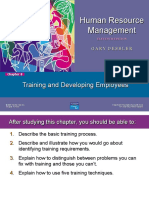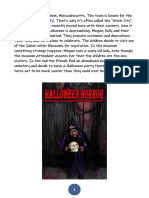Training and Developing Employees: Human Resource Management
Training and Developing Employees: Human Resource Management
Uploaded by
Kave MathiCopyright:
Available Formats
Training and Developing Employees: Human Resource Management
Training and Developing Employees: Human Resource Management
Uploaded by
Kave MathiOriginal Title
Copyright
Available Formats
Share this document
Did you find this document useful?
Is this content inappropriate?
Copyright:
Available Formats
Training and Developing Employees: Human Resource Management
Training and Developing Employees: Human Resource Management
Uploaded by
Kave MathiCopyright:
Available Formats
HUMAN RESOURCE MANAGEMENT
Chapter 8
Training and
Developing
Employees
PowerPoint Presentation by Charlie Cook
Copyright © 2011 Pearson Education GARY DESSLER The University of West Alabama
LEARNING OUTCOMES
1. Summarize the purpose and process
of employee orientation.
2. List and briefly explain each of the four steps
in the training process.
3. Discuss how you would motivate trainees.
4. Describe and illustrate how you would identify
training requirements.
5. Explain how to distinguish between problems
you can fix with training and those you can’t.
6. Explain how to use five training techniques.
Copyright © 2011 Pearson Education 8–2
LEARNING OUTCOMES (cont’d)
7. List and briefly discuss four management
development programs.
8. List and briefly discuss the importance of the eight
steps in leading organizational change.
9. Answer the question, “What is organizational
development and how does it differ from traditional
approaches to organizational change?”
Copyright © 2011 Pearson Education 8–3
The Training
Process
• Training
Is the process of teaching new employees
the basic skills they need to perform their jobs
Is a hallmark of good management
Reduces an employer’s exposure to negligent
training liability
• Training’s Strategic Context
The aims of firm’s training programs must make
sense in terms of the company’s strategic
goals.
Training fosters employee learning, which
results in enhanced organizational
performance.
Copyright © 2011 Pearson Education 8–4
Steps in the Training
Process
The Four-Step Training
Process
1 Analysis of the training needs
2 Design of the training module
3 Developing of the contents
4 Implementation of the training
5 Evaluation of the training
Copyright © 2011 Pearson Education effectiveness 8–5
Analyzing Training
Needs
Training Needs
Analysis
Task Analysis: Performance Analysis:
Assessing new employees’ Assessing current employees’
training needs training needs
Copyright © 2011 Pearson Education 8–6
FIGURE 8–2 Example of Competency Model for Human Resource Manager
Copyright © 2011 Pearson Education 8–7
Performance Analysis:
Assessing Current Employees’ Training Needs
Specialized Software
Assessment Center
Performance Appraisals
Results
Individual Diaries Methods Job-Related Performance
for Identifying Data
Training Needs
Attitude Surveys Observations
Test Interviews
s
Can’t-do or Won’t-do?
Copyright © 2011 Pearson Education 8–8
DESIGNING THE TRAINING
• SETTING LEARNING OBJECTIVES
• CREATING A MOTIVATIONAL LEARNNG
ENVIRONMENT
• MAKE THE LEARNING MEANINGFUL
• MAKE SKILLS TRANSFER OBVIOUS AND EASY
• REINFORCE THE LEARNING
• ENSURE TRANSFER OF LEARNING ON THE JOB
DEVELOPING THE TRAINING METHODS
• On-the-Job Training • Computer-Based Training
• Apprenticeship Training (CBT)
• Informal Learning • Simulated Learning
• Job Instruction Training • Internet-Based Training
• Lectures • Learning Portals
• Programmed Learning
• Audiovisual-Based Training
• Vestibule Training
• Teletraining and
Videoconferencing
• Electronic Performance
Support Systems (EPSS)
Copyright © 2011 Pearson Education 8–10
You might also like
- Dan Kennedy - Copywriting MasteryDocument20 pagesDan Kennedy - Copywriting MasteryOnai Munyati100% (6)
- Kuroda vs. Jalandoni (42 OG 4282) Case DigestDocument2 pagesKuroda vs. Jalandoni (42 OG 4282) Case DigestCarlota Nicolas Villaroman89% (9)
- Chapter 7: Training: Learning ObjectivesDocument9 pagesChapter 7: Training: Learning ObjectivesHendriech Del MundoNo ratings yet
- Training: Session ExtractsDocument11 pagesTraining: Session Extractsdumindu1No ratings yet
- Humanistica Lovaniensia Vol. 15, 1959 - STEPHANI VINANDI PIGHII EPISTOLARIUM PDFDocument557 pagesHumanistica Lovaniensia Vol. 15, 1959 - STEPHANI VINANDI PIGHII EPISTOLARIUM PDFVetusta MaiestasNo ratings yet
- Training and Developing Employees: Global Edition 12eDocument22 pagesTraining and Developing Employees: Global Edition 12eMohamed SulubNo ratings yet
- Week 14 - Pelatihan Dan Pengembangan SDM - ErvinaDocument45 pagesWeek 14 - Pelatihan Dan Pengembangan SDM - ErvinaMutia ZahrotunnisaNo ratings yet
- Training and Developing Employees: Global Edition 12eDocument46 pagesTraining and Developing Employees: Global Edition 12edenden007No ratings yet
- Chapter Seven - Training and DevelopmentDocument20 pagesChapter Seven - Training and Developmentyaxyesahal123No ratings yet
- Training and Developing Employees: Global Edition 12eDocument47 pagesTraining and Developing Employees: Global Edition 12eRohit Kumar 4170No ratings yet
- Training and Developing Employees: Global Edition 12eDocument41 pagesTraining and Developing Employees: Global Edition 12eĐàm Quang Thanh TúNo ratings yet
- Training & DevelopmentDocument35 pagesTraining & Developmentmd yousufNo ratings yet
- FALLSEM2019-20 MGT1023 ETH VL2019201002627 Reference Material I 19-Sep-2019 Dessler s6 To8 T DDocument45 pagesFALLSEM2019-20 MGT1023 ETH VL2019201002627 Reference Material I 19-Sep-2019 Dessler s6 To8 T DRakshit GuptaNo ratings yet
- Human Resource Management 12e - 7Document46 pagesHuman Resource Management 12e - 7Monica RizkaNo ratings yet
- HRM-Session 7 - Training and Developing EmployeesDocument32 pagesHRM-Session 7 - Training and Developing EmployeeszainabkhilalNo ratings yet
- Chapter 8-Part 1Document14 pagesChapter 8-Part 1rawan.tantawyNo ratings yet
- Chapter 8Document43 pagesChapter 8mromarshehataNo ratings yet
- Dessler HRM12e PPT 08Document38 pagesDessler HRM12e PPT 08Deep ThinkerNo ratings yet
- Training and Development - Lecture 13Document10 pagesTraining and Development - Lecture 13UMAR faROOQNo ratings yet
- 6 T_DDocument44 pages6 T_DphamthihuyenaikatsuNo ratings yet
- Training & Developing EmployeeDocument23 pagesTraining & Developing EmployeeAbdurrohimnNo ratings yet
- Training and Developing EmployeesDocument15 pagesTraining and Developing EmployeesTamanna AkterNo ratings yet
- MGT-351 Human Resource Management Chapter-8 Training and DevelopmentDocument28 pagesMGT-351 Human Resource Management Chapter-8 Training and DevelopmentFariha Mehzabin NoshinNo ratings yet
- Human Resource ManagementDocument39 pagesHuman Resource ManagementHaroon AmjadNo ratings yet
- Training and Developing Employees: Global Edition 12eDocument17 pagesTraining and Developing Employees: Global Edition 12ePUNK ASSNo ratings yet
- Human Resource Management: Training and Developing EmployeesDocument26 pagesHuman Resource Management: Training and Developing EmployeesIbrar IshaqNo ratings yet
- Chapter 8-Part 2Document15 pagesChapter 8-Part 2rawan.tantawyNo ratings yet
- Chapter 6 Training and DevelopmentDocument36 pagesChapter 6 Training and DevelopmentsamavaashiqNo ratings yet
- Dessler - HRM16e - PPT - 07 Training and Developing EmployeeDocument42 pagesDessler - HRM16e - PPT - 07 Training and Developing EmployeeDoeurn ChandethNo ratings yet
- Human Resource Mangement - MANDocument21 pagesHuman Resource Mangement - MANKathrina Agbulos-VillavecencioNo ratings yet
- L & D Module 1Document83 pagesL & D Module 1surbhiNo ratings yet
- HRM - Week 5 - Chapter 8Document34 pagesHRM - Week 5 - Chapter 8Nguyễn Mai HươngNo ratings yet
- HRM Dessler 08 Training and DevelopmentDocument52 pagesHRM Dessler 08 Training and DevelopmentQila Qils Ecky100% (6)
- T&D, TNA, TypesDocument21 pagesT&D, TNA, TypesSagar chaudhariNo ratings yet
- Chapter 8: Training and Developing EmployeesDocument38 pagesChapter 8: Training and Developing Employeessyed zamanNo ratings yet
- Training and DevlopmentsDocument29 pagesTraining and DevlopmentsaarchishahhNo ratings yet
- Dessler Ch8 Training DevelopmentDocument48 pagesDessler Ch8 Training Developmentawarmalik shanNo ratings yet
- Traing Need Assment Comp chpt6Document26 pagesTraing Need Assment Comp chpt6Ayush BankarNo ratings yet
- General Presentation-Employee Training and DevelopmentDocument20 pagesGeneral Presentation-Employee Training and DevelopmentSadia SultanaNo ratings yet
- Measures of Training SuccessDocument55 pagesMeasures of Training SuccessMehdi MohmoodNo ratings yet
- CH 7 - Training & Developing EmployeesDocument23 pagesCH 7 - Training & Developing Employeeshadeel.walid22No ratings yet
- This Study Resource Was: Training and Developing EmployeesDocument9 pagesThis Study Resource Was: Training and Developing EmployeesNouman AhmadNo ratings yet
- HR Training and DevelopmentDocument21 pagesHR Training and DevelopmentAnonymous XPPu3qNo ratings yet
- Chapter 7: Training: Presenters: Sara Nadia MY GMO4317 Shadi Khakpour GM04058Document35 pagesChapter 7: Training: Presenters: Sara Nadia MY GMO4317 Shadi Khakpour GM04058Sara NadiaNo ratings yet
- Human Resource Management: Training and Developing EmployeesDocument28 pagesHuman Resource Management: Training and Developing EmployeesUzzaam HaiderNo ratings yet
- Performance Management and Appraisal: Part Three - Training and DevelopmentDocument50 pagesPerformance Management and Appraisal: Part Three - Training and Developmentarmaan malikNo ratings yet
- Chapter 8 Training and DevelopmentDocument37 pagesChapter 8 Training and DevelopmentKumar TamangNo ratings yet
- Dessler08 091202133437 Phpapp02Document14 pagesDessler08 091202133437 Phpapp02srkwin6No ratings yet
- MSDM pertemuan 7 dan 8Document45 pagesMSDM pertemuan 7 dan 8krisliana16No ratings yet
- Human Resource Management: Fundamentals ofDocument53 pagesHuman Resource Management: Fundamentals ofAr-Rayyan AshNo ratings yet
- TrainingDevelopment - Session 5 - 6Document34 pagesTrainingDevelopment - Session 5 - 6rohitgoyal207No ratings yet
- HRM 06 Training and DevelopmentDocument30 pagesHRM 06 Training and DevelopmentDzul AssrensNo ratings yet
- Trainingdesigningprocess 210926164700Document12 pagesTrainingdesigningprocess 210926164700SAMEENA NAWAZNo ratings yet
- HRM Module 5Document62 pagesHRM Module 5Soumya Kesharwani100% (1)
- Presentation Icogpass 2022 - Renie Dwi SDocument13 pagesPresentation Icogpass 2022 - Renie Dwi SrenieNo ratings yet
- Topic 3 - Onboarding and TrainingDocument36 pagesTopic 3 - Onboarding and TrainingdinieNo ratings yet
- Chapter 8 Training - DevelopmentDocument15 pagesChapter 8 Training - Developmentmuneeb chishtiNo ratings yet
- Pelatihan Dan Pengembangan (5-6)Document75 pagesPelatihan Dan Pengembangan (5-6)TIKANo ratings yet
- Chapter 6 - HRM - PCIUDocument21 pagesChapter 6 - HRM - PCIUSalman KhanNo ratings yet
- Week 10-Training and DevelopmentDocument27 pagesWeek 10-Training and DevelopmentMazin MostafaNo ratings yet
- Training and Developing Employees: T EightDocument14 pagesTraining and Developing Employees: T EightNouman AhmadNo ratings yet
- Module - CHAPTER 8.2 - TrainingDocument9 pagesModule - CHAPTER 8.2 - TrainingBethany HeartfiliaNo ratings yet
- Particulars Amt: Trading, Profit and Loss A/CDocument5 pagesParticulars Amt: Trading, Profit and Loss A/CKave MathiNo ratings yet
- No of Years Fvif RateDocument9 pagesNo of Years Fvif RateKave MathiNo ratings yet
- Quiz On National Income AggregatesDocument5 pagesQuiz On National Income AggregatesKave MathiNo ratings yet
- Impact of Covid 19 On Small Businesses in The Indian EconomyDocument1 pageImpact of Covid 19 On Small Businesses in The Indian EconomyKave MathiNo ratings yet
- Anchoring Bias:: Decision Making Errors and BiasDocument2 pagesAnchoring Bias:: Decision Making Errors and BiasKave MathiNo ratings yet
- OM QuizDocument8 pagesOM QuizKave MathiNo ratings yet
- Segmentation, Targeting, and Positioning - NotesDocument60 pagesSegmentation, Targeting, and Positioning - NotesKave MathiNo ratings yet
- NOMINAL-No Mathematical OperationsDocument1 pageNOMINAL-No Mathematical OperationsKave MathiNo ratings yet
- Introduction To MarketingDocument7 pagesIntroduction To MarketingKave MathiNo ratings yet
- SegmentationDocument33 pagesSegmentationKave MathiNo ratings yet
- AccDocument8 pagesAccKave MathiNo ratings yet
- Segmentation, Targeting, and Positioning: Building The Right Relationships With The Right CustomersDocument60 pagesSegmentation, Targeting, and Positioning: Building The Right Relationships With The Right CustomersKave MathiNo ratings yet
- TargetingDocument18 pagesTargetingKave MathiNo ratings yet
- Facility LocationDocument36 pagesFacility LocationKave MathiNo ratings yet
- The Marketing Environment - NotesDocument16 pagesThe Marketing Environment - NotesKave MathiNo ratings yet
- Definitions of QualityDocument48 pagesDefinitions of QualityKave MathiNo ratings yet
- Marketing Mix - NotesDocument12 pagesMarketing Mix - NotesKave MathiNo ratings yet
- A Framework For ForecastingDocument28 pagesA Framework For ForecastingKave MathiNo ratings yet
- Discipline 2020Document21 pagesDiscipline 2020Kave MathiNo ratings yet
- The Waiting Line ProblemDocument26 pagesThe Waiting Line ProblemKave MathiNo ratings yet
- Human Resource Management: Performance Management and AppraisalDocument34 pagesHuman Resource Management: Performance Management and AppraisalKave Mathi100% (2)
- Job Analysis 2020Document23 pagesJob Analysis 2020Kave MathiNo ratings yet
- Material Requirements PlanningDocument36 pagesMaterial Requirements PlanningKave MathiNo ratings yet
- Grievance & Its Handling ProcedureDocument14 pagesGrievance & Its Handling ProcedureKave MathiNo ratings yet
- Human Resource Management: Careers, and Talent ManagementDocument20 pagesHuman Resource Management: Careers, and Talent ManagementKave MathiNo ratings yet
- Dennett's Reduction of Brentano's Intentionality by Brent SilbyDocument9 pagesDennett's Reduction of Brentano's Intentionality by Brent SilbyBrent SilbyNo ratings yet
- Miaa 330 FinalprojectDocument12 pagesMiaa 330 Finalprojectapi-245618218No ratings yet
- Annaliza C. Chan vs. Atty. Rebene C. Carrera (A.C. No. 10439. September 3, 2019)Document8 pagesAnnaliza C. Chan vs. Atty. Rebene C. Carrera (A.C. No. 10439. September 3, 2019)HarleneNo ratings yet
- c++ - Primer 4e 習題解答Document145 pagesc++ - Primer 4e 習題解答呂昕儒No ratings yet
- Apa Form - Dialogue - 2022 (Goal Setting)Document16 pagesApa Form - Dialogue - 2022 (Goal Setting)Giorgi PapavaNo ratings yet
- AD&D - Country Sites PDFDocument98 pagesAD&D - Country Sites PDFR.c. Quaresma100% (1)
- Little Nine PDFDocument7 pagesLittle Nine PDFdiamond68100% (1)
- Global Action Plan For The Prevention and Control of Ncds 2013 To 2020 FlyerDocument2 pagesGlobal Action Plan For The Prevention and Control of Ncds 2013 To 2020 FlyermonzcoNo ratings yet
- Islamic studiesDocument14 pagesIslamic studiesirammir133No ratings yet
- B.SC., Physics: Sri Krishnadevaraya University:: AnantapuramuDocument15 pagesB.SC., Physics: Sri Krishnadevaraya University:: AnantapuramuHiNo ratings yet
- Oakland County Brief Filed in MI Appeals CourtDocument100 pagesOakland County Brief Filed in MI Appeals CourtAnonymous dp5b3X1NANo ratings yet
- MGT 251 Cases Fall 2020Document5 pagesMGT 251 Cases Fall 2020Khondokar Fardin IslamNo ratings yet
- Romesocietyand CultureDocument3 pagesRomesocietyand CultureDr.CHARLES CHRISTOPHER RAJNo ratings yet
- Konseling Tentang Kesehatan ReproduksiDocument2 pagesKonseling Tentang Kesehatan ReproduksiClarissa JulianaNo ratings yet
- A1Document3 pagesA1MikneyNo ratings yet
- User's Manual: Power Ge'ez 2010™Document27 pagesUser's Manual: Power Ge'ez 2010™kidia100% (1)
- Hotel Says Goodbye To A Clean CoupleDocument3 pagesHotel Says Goodbye To A Clean CoupleAngela Muñoz JuárezNo ratings yet
- English Test 2Document5 pagesEnglish Test 2ErickChávezNo ratings yet
- According To Hindu Mythology, How Many Loks Are There - QuoraDocument1 pageAccording To Hindu Mythology, How Many Loks Are There - Quoratgkbc5bgsgNo ratings yet
- THR Rolr Halal Science (Aliyah)Document22 pagesTHR Rolr Halal Science (Aliyah)Maisaroh AliyahNo ratings yet
- Data KataDocument392 pagesData KatameeNo ratings yet
- Effect of Social Media On Students ..................Document6 pagesEffect of Social Media On Students ..................architayadav861No ratings yet
- Object-Oriented PHP (Chapter 6)Document22 pagesObject-Oriented PHP (Chapter 6)muhammad safwanNo ratings yet
- Scuderia Ferrari Orologi Operating Instructions, Care & Maintenance, and Warranty & Service InformationDocument40 pagesScuderia Ferrari Orologi Operating Instructions, Care & Maintenance, and Warranty & Service InformationDuta Narendratama0% (1)
- Teens 2 Halloween Horror by Gina ClemenDocument19 pagesTeens 2 Halloween Horror by Gina Clementomas acostaNo ratings yet
- Nickelback Never Gonna Be AloneDocument2 pagesNickelback Never Gonna Be Alonenaytunaung76500% (1)
- ANAPHY Lec Session #13 - SAS (Agdana, Nicole Ken)Document9 pagesANAPHY Lec Session #13 - SAS (Agdana, Nicole Ken)Nicole Ken AgdanaNo ratings yet


















































































































